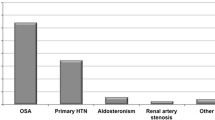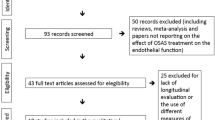Summary
Introduction Obstructive sleep apnea syndrome (OSAS) is frequently associated with cardiovascular disease. We investigated endothelium-dependent and endothelium-independent nitric oxide-mediated vasodilatory function in normotensive patients with OSAS using the hand vein compliance technique. Patients and methods Dose-response curves to the endothelium-dependent vasodilator bradykinin were obtained in 23 male subjects with OSAS and 12 male control subjects of comparable age, height, and weight. Results Mean (±SD) maximum dilation (Emax) to bradykinin was significantly lower in OSAS patients than in controls (59.8±26.0 vs. 94.8±9.5%, p<0.0001). Mean vasodilation with nitroglycerin was not diminished in the OSAS group (90.7±30.5 vs. 100.3±12.9% in controls; n.s.). In 11 OSAS patients, a follow-up investigation was performed after at least 2 months of treatment with nasal continuous positive airway pressure (CPAP): Emax to bradykinin rose from 54.5±19.2% to 111.5±25.1% after treatment (p<0.001). Mean vasodilation to nitroglycerin was unchanged. Conclusions These results suggest that endothelium-dependent nitric oxide-mediated vasodilation is impaired in patients with OSAS due to an impaired function in the endothelial cells. This impairment is reversible with CPAP treatment.
Zusammenfassung
Einleitung Das obstruktive Schlafapnoe-Syndrom (OSAS) ist häufig mit kardiovaskulären Erkrankungen assoziiert. Zur Erkennung möglicher pathophysiologischer Zusammenhänge zwischen OSAS und kardiovaskulären Erkrankungen untersuchten wir daher die Gefäßreagibilität bei normotensiven OSAS-Patienten. Patienten und Methodik Bei 23 männlichen OSAS-Patienten und 12 gesunden männlichen Kontrollprobanden mit vergleichbarem Alter, Größe und Gewicht wurden Dosis-Wirkungskurven nach Gabe des endothelabhängigen Vasodilatators Bradykinin und einer Einzeldosis des endothelunabhängig wirkenden Nitroglycerins mit der Handvenen-Compliancetechnik in vivo bestimmt. Ergebnisse Die mittlere (±Standardabweichung) maximale Gefäßdilatation (Emax) nach Gabe von Bradykinin war bei den OSAS-Patienten signifikant niedriger als in der Kontrollgruppe (59,8±26,0 vs. 94,8±9,5%, p<0,0001). Hingegen war die mittlere Gefäßdilatation nach Gabe von Nitroglycerin in der OSAS-Gruppe nicht signifikant erniedrigt (90,7±30,5 vs. 100,3±12,9% in der Kontrollgruppe; n.s.). Bei 11 der OSAS-Patienten konnte eine Verlaufsuntersuchung nach mindestens zweimonatiger Behandlung mit einer nasalen Überdruck (CPAP)- Therapie durchgeführt werden. Bei diesen Patienten wurde eine Verbesserung der Emax-Werte nach Bradykiningabe von initial 54,5±19,2% auf 111,5±25,1% unter CPAP-Therapie erreicht (p<0,001). Die Vasodilatation nach Nitroglycerin blieb hingegen im Mittel unverändert. Schlussfolgerungen Es konnte gezeigt werden, dass die endothelabhängige Vasodilatation bei Patienten mit OSAS aufgrund einer Dysfunktion der Gefäßendothelzellen gestört ist. Diese endotheliale Dysfunktion ist unter nCPAP-Therapie reversibel.
Similar content being viewed by others
Author information
Authors and Affiliations
Additional information
Eingegangen: 3. Januar 2001 Akzeptiert: 5. Februar 2001
Rights and permissions
About this article
Cite this article
Duchna, HW., Guilleminault, C., Stoohs, R. et al. Das obstruktive Schlafapnoe-Syndrom: Ein kardiovaskulärer Risikofaktor?. Z Kardiol 90, 568–575 (2001). https://doi.org/10.1007/s003920170125
Issue Date:
DOI: https://doi.org/10.1007/s003920170125




